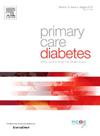Estimation of the population atributable fraction due a to excess body fat in primary care patients: IBERICAN study
IF 2.6
4区 医学
Q3 ENDOCRINOLOGY & METABOLISM
引用次数: 0
Abstract
The burden of disease attributable to excess body fat (EBF) in type 2 diabetes mellitus (T2DM) may be underestimated due to problems correlating BMI with body fat. The aim of this study is to compare the population attributable fraction (PAF) of EBF in T2DM assessed with various parameters.
Material and methods
Prevalence study based on the baseline visit of the IBERICAN study. Mixed unconditional logistic regression models were used to estimate the risk of T2DM for the various categories of BMI, of the estimation of EBF according to the CUN-BAE (Clínica Universidad de Navarra-Body Adiposity Estimator) and of waist circumference (WC), stratifying by sex. The PAF was calculated for each of the EBF estimates.
Results
A total of 7752 patients from IBERICAN study were eligible, of them 1536 (19.8 %) achieved T2DM criterion, The prevalence of diabetes was higher in men, in those with a lower level of education, and in those who reported a low level of physical activity. Subjects with diabetes were older, had a higher BMI, a higher CUN-BAE-estimated body fat percentage (eBFP) and a higher waist circumference. One in three cases T2DM risk was attributed to elevated BMI, whereas in the CUN-BAE case it was attributed to 9 out of 10 men and 2 out of 3 women. One out of two cases of T2DM in women, and less in men, was attributed to an excess WC.
Conclusions
The burden of disease attributable to EBF in the case of T2DM may be underestimated. Therefore, EBF should be used, together with BMI, WC -especially in women-, and the CUN-BAE to better estimate the risk of T2DM and to adapt dietary or lifestyle recommendations in daily clinical practice.
估计初级保健患者体内脂肪过多的人群可归因比例:伊比利亚研究。
由于BMI与体脂相关的问题,2型糖尿病(T2DM)中归因于体脂过多(EBF)的疾病负担可能被低估。本研究的目的是比较不同参数评估的T2DM患者EBF的人群归因分数(PAF)。材料和方法:基于伊比利亚研究基线访问的患病率研究。使用混合无条件逻辑回归模型对不同类别BMI、根据cune - bae (Clínica universsidad de Navarra-Body obesity Estimator)估计EBF和腰围(WC)进行T2DM风险的估计,并按性别分层。PAF是为每个EBF估计计算的。结果:IBERICAN研究共纳入7752例患者,其中1536例(19.8% %)达到T2DM标准,糖尿病患病率在男性、低教育水平人群和低体力活动人群中较高。糖尿病患者年龄较大,BMI指数较高,un - bae估计体脂率(eBFP)较高,腰围较高。三分之一的2型糖尿病风险归因于BMI升高,而在con - bae病例中,10个男性中有9个,3个女性中有2个。1 / 2的女性2型糖尿病患者归因于过量的WC,而男性较少。结论:在T2DM病例中,EBF引起的疾病负担可能被低估。因此,EBF应与BMI、WC(尤其是女性)和un - bae一起使用,以更好地估计2型糖尿病的风险,并在日常临床实践中调整饮食或生活方式建议。
本文章由计算机程序翻译,如有差异,请以英文原文为准。
求助全文
约1分钟内获得全文
求助全文
来源期刊

Primary Care Diabetes
ENDOCRINOLOGY & METABOLISM-PRIMARY HEALTH CARE
CiteScore
5.00
自引率
3.40%
发文量
134
审稿时长
47 days
期刊介绍:
The journal publishes original research articles and high quality reviews in the fields of clinical care, diabetes education, nutrition, health services, psychosocial research and epidemiology and other areas as far as is relevant for diabetology in a primary-care setting. The purpose of the journal is to encourage interdisciplinary research and discussion between all those who are involved in primary diabetes care on an international level. The Journal also publishes news and articles concerning the policies and activities of Primary Care Diabetes Europe and reflects the society''s aim of improving the care for people with diabetes mellitus within the primary-care setting.
 求助内容:
求助内容: 应助结果提醒方式:
应助结果提醒方式:


